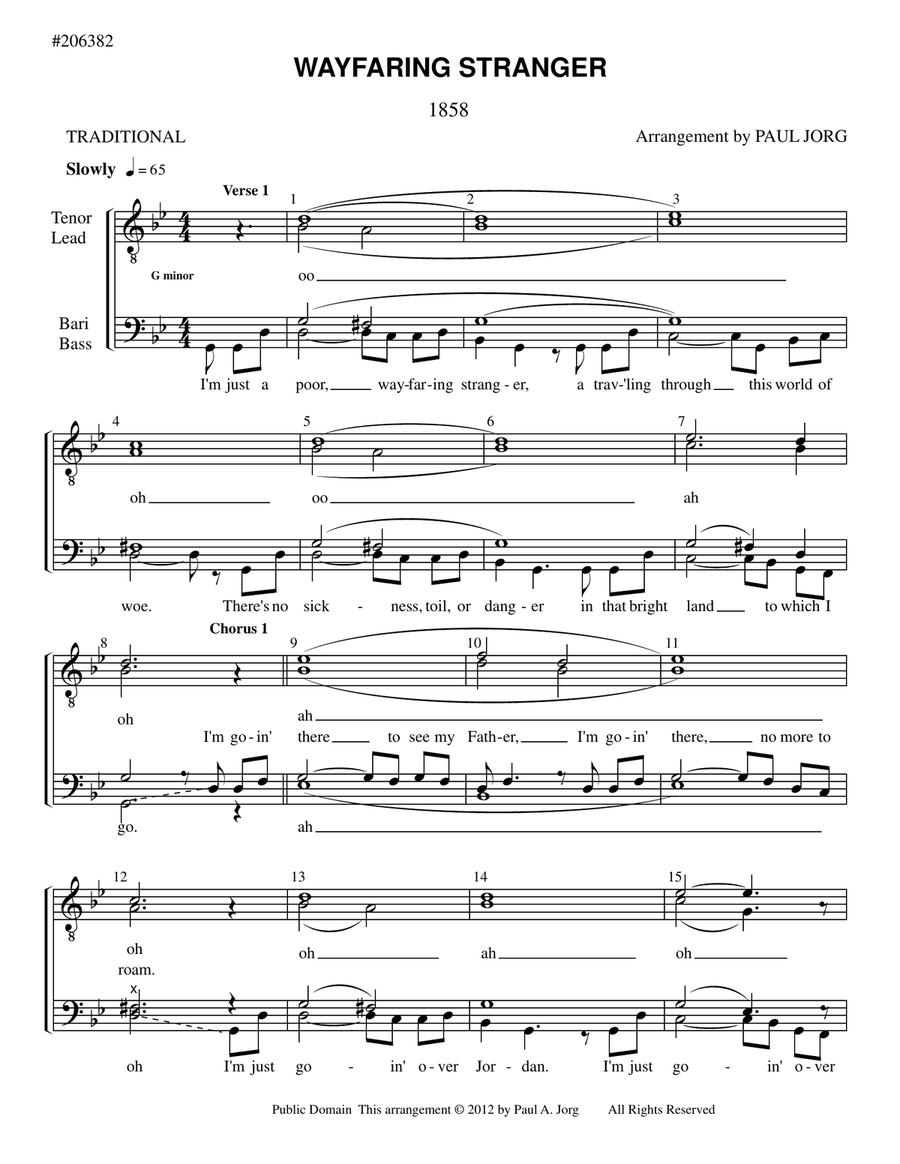Choral Choir (TTBB) - Level 1 - Digital Download SKU: A0.522333 Composed by Unknown - traditional. Arranged by Paul A. Jorg. Christian,Spiritual,Traditional. Octavo. 4 pages. Paul A. Jorg #5869331. Published by Paul A. Jorg (A0.522333). This song is public domain, written in the 1850's, during a time - pre-civil war - when the nation was being torn apart. The writer calms his anxiety by holding on to God's promises. Here are some lyric notes: I am a poor, wayfaring stranger - Wayfaring: traveling especially on foot; peripatetic country preachers; a poor wayfaring stranger. Wandering through this world of woe - Matthew 18:7: Woe to the world because of the things that cause people to sin! Such things must come, but woe to the man through whom they come! And there's no sickness, toil or danger - John 11:4: When he heard this, Jesus said, This sickness will not end in death. No, it is for God's glory so that God's Son may be glorified through it. Ecclesiastes 2:18-19: I hated all the things I had toiled for under the sun, because I must leave them to the one who comes after me. Acts 14:22: strengthening the disciples and encouraging them to remain true to the faith. We must go through many hardships to enter the kingdom of God, In that bright land to which I go - James 1:17 Every good and perfect gift is from above, coming down from the Father of the heavenly lights, who does not change like shifting shadows.I'm going home to see my Father - John 6:40 - For my Father's will is that everyone who looks to the Son and believes in him shall have eternal life, and I will raise him up at the last day. I'm only going over Jordan - Joshua 22:4: Now that the LORD your God has given your brothers rest as he promised, return to your homes in the land that Moses the servant of the LORD gave you on the other side of the Jordan. Yet though dark clouds will gather round me - 2 Corinthians 12:10: That is why, for Christ's sake, I delight in weaknesses, in insults, in hardships, in persecutions, in difficulties. For when I am weak, then I am strong. I know my way is rough and steep - Psalm 16:11: You have made known to me the path of life; you will fill me with joy in your presence, with eternal pleasures at your right hand. Proverbs 15:24: The path of life leads upward for the wise to keep him from going down to the grave.But beauteous fields lie just before me - Numbers 13:25: We arrived in the land you sent us to see, and it is indeed a magnificient country, a land flowing with milk and honey. Where God's redeemed their vigil's keep - Exodus12:42: Because the LORD kept vigil that night to bring them out of Egypt, on this night all the Israelites are to keep vigil to honor the LORD for the generations to come. I'm going home to see my mother - Mark 10:29-31: I tell you the truth, Jesus replied, no one who has left home or brothers or sisters or mother or father or children or fields for me and the gospel will fail to receive a hundred times as much in this present age (homes, brothers, sisters, mothers, children and fields-and with them, persecutions.
